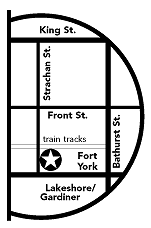
 |
Fallen Soldiers, Forgotten Park : : : : : : : Walking south on Strachan from King, things look a little bleak. The sidewalks and road are in terrible repair. The police station to the left and the towing company on the right do nothing to improve the view, nor does the Gardiner Expressway looming above. But as Strachan rises above the railway tracks below, it reveals a pair of crumbling pedestals on its East side, bookending a wooden staircase. The stairs lead down approximately forty feet, to an unexpected relief from the concrete and the fast-moving vehicles above. Here, there are acres of lush grass, framed by mature trees (poplar, hemlock, maple, oak), and dotted with benches. It is a surprisingly quiet place, rarely disturbed by traffic of the vehicular or human variety. It exists thanks to its establishment, in 1863, as a military burial ground, and to the City's 1961 decision to transfer its governance to the Toronto Historical Board. All that remains of the cemetery's headstones have been collected into one central monument, leaving the remainder of the land for public recreational use. Adjacent to Historic Fort York, it is part of a tract of land that Henry Scadding described, in 1873, as bearing "the same relationship to modern Toronto as the Plains of Abraham do to Quebec". Currently, this land can be best described as an amazingly underused urban refuge. : : : : : : : Ft. York Military Cemetary South of Front St., tucked between train tracks, a cop shop and the Gardiner Expressway; west side of Ft. York. Transit · Streetcar: Strachan stop on Bathurst Exhibition route |
 |
spacing.ca || contact || subscribe || in this issue || stores
(c) 2003 Toronto
Public Space Committee
email: info@publicspace.ca